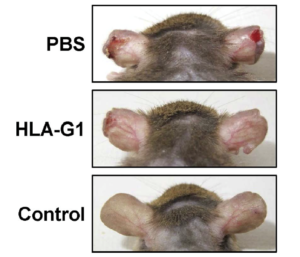Countering atopic dermatitis immune reactions
Research Press Release | August 04, 2017
A protein which protects the fetus during pregnancy, HLA-G1, shows high potential for treating atopic dermatitis and other related diseases.
Human leukocyte antigen (HLA)-G is a protein that interacts with specific cell receptors to inhibit immune responses. The protein is best known for its role in protecting the fetus from attack by its mother’s immune system. A team of researchers from Hokkaido University in Japan successfully used it to treat mice with an induced form of atopic dermatitis.
Atopic dermatitis is a chronic form of eczema commonly seen in developed countries, particularly in children. It occurs as a result of a hypersensitive immune reaction but the exact mechanism is unknown. It causes redness of the skin, itchiness, scaling and vesicles.
According to the paper published in the journal International Immunopharmacology, Professor Katsumi Maenaka and his team used an extract made from a common dust mite to induce atopic dermatitis in mice. Dust mites are known as a causative allergen in atopic dermatitis. Bleeding, scarring and dry skin were evident after applying the extract on and around the mice’s ears for 15 days. Blood samples also showed evidence of an immune reaction. The affected areas around the ears were then treated with topical HLA-G1, a major form of HLA-G, every other day for 20 days. These HLA-G1 proteins had been produced in bacteria and purified for the experiments.
Mice treated with HLA-G1 showed marked improvement of the skin lesions. Blood samples also showed a reduced immune response compared to mice that weren’t treated with HLA-G1. The results suggest that HLA-G1 could improve conditions by suppressing an excessive allergic reaction in the atopic dermatitis model. Importantly, the treated mice didn’t show weight loss, a common side effect in anti-atopic dermatitis treatments. Other experiments showed that HLA-G1’s suppressive function involves the inhibition of lymphocytes that work in allergic reactions.
The team previously reported that HLA-G proteins can suppress joint swelling in an animal model for rheumatoid arthritis. “Our study provides novel insights on the function of HLA-G proteins, which can provide clues on efficient therapeutic strategies for patients with atopic dermatitis, rheumatoid arthritis and other related diseases. Further investigation is needed to better understand HLA-G’s suppressive mechanism against excessive immune reactions,” says Katsumi Maenaka.
Original article:
Maeda N., et al., Therapeutic application of human leukocyte antigen-G1 improves atopic dermatitis-like skin lesions in mice. International Immunopharmacology, July 1, 2017.
DOI: 10.1016/j.intimp.2017.06.026
Funding information:
This research is partially supported by the Platform Project for Supporting in Drug Discovery and Life Science Research from the Ministry of Education, Culture, Sports, Science and Technology (MEXT)(12723020), Japan Agency for Medical Research and Development (AMED) (17933644), and a Grant-in-Aid Scientific Research by the Japan Society for the Promotion of Science (JSPS) (15H02384).
Contacts:
Professor Katsumi Maenaka
Email: maenaka[at]pharm.hokudai.ac.jp
Assistant Professor Kimiko Kuroki
Email: k-kimiko[at]pharm.hokudai.ac.jp
Faculty of Pharmaceutical Science
Hokkaido University
Naoki Namba (Media Officer)
Global Relations Office
Institute for International Collaboration
Hokkaido University
Tel: +81-11-706-2185
Email: pr[at]oia.hokudai.ac.jp

